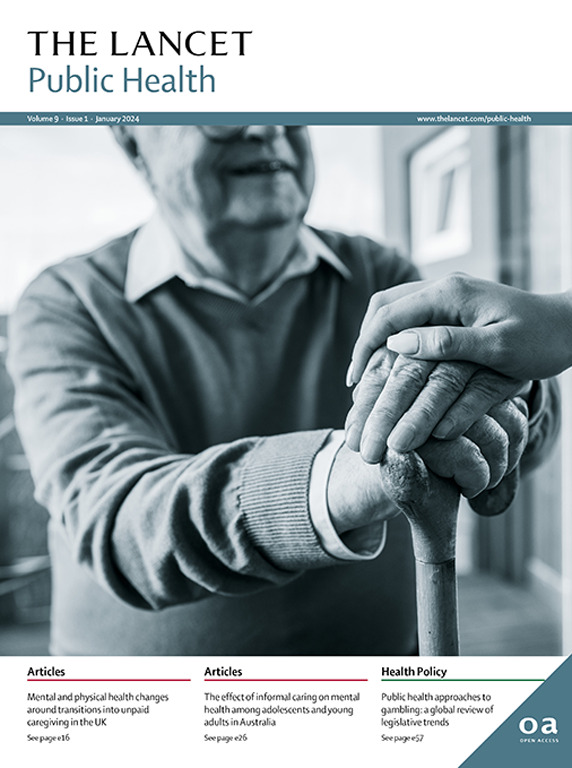COVID-19 大流行期间的城市流动模式:全球自然实验分析
IF 25.2
1区 医学
Q1 PUBLIC, ENVIRONMENTAL & OCCUPATIONAL HEALTH
引用次数: 0
摘要
背景在 COVID-19 大流行期间,世界各地的城市交通模式都发生了变化,包括主动交通(步行、骑自行车、微型交通和公共交通使用),这为全球公共卫生教训和行动创造了一个独特的机会。我们旨在分析一项全球自然实验,探索大流行期间的城市交通模式,以及这些模式与 COVID-19 相关政策的实施之间的关系。方法我们从苹果公司的《交通趋势报告》中获取了 2020 年 1 月 13 日至 2022 年 2 月 4 日期间 296 个城市的交通指数数据。流动性指数代表的是疫情流行前(定义为 2020 年 1 月 13 日)苹果地图对驾驶、步行和公共交通出行的查询频率,相对于基线值 100。城市交通指数轨迹按国家收入水平、交通相关城市类型、人口密度和 COVID-19 大流行严重程度(SARS-CoV-2 感染率)分层绘制。我们还利用 "移动街道 "数据集综合分析了促进或限制城市流动性和主动交通(步行、骑自行车、微型交通和公共交通)的全球大流行政策和恢复行动。此外,我们还在全球范围内进行了一次自然实验,评估了新的主动交通政策对全球城市步行和公共交通使用的影响。我们使用多变量回归和差异分析(DID)来探讨步行或公共交通推广政策的实施是否会影响流动性指数,并对干预前(2020 年 1 月 27 日至 4 月 12 日)和干预后(2020 年 4 月 13 日至 6 月 28 日)实施和未实施这些政策的城市进行了比较。研究结果根据城市流动性指数轨迹,我们观察到大流行初期步行、驾车和公共交通的流动性指数整体下降,但这些数值在 2020 年 4 月开始上升。与人口密度较高的城市相比,人口密度较低的城市的驾驶和步行指数普遍较高,而人口密度较高的城市的公共交通指数较高。流行病严重程度较高的城市的驾驶和步行指数通常高于流行病严重程度较低的城市,而流行病严重程度较低的城市的公共交通指数高于其他城市。我们在 33 个国家(19 个高收入国家、11 个中等收入国家和 3 个低收入国家)的 230 个城市的数据集中确定了 587 项已知实施日期且与主动交通相关的政策,其中包括 305 项关于步行的政策、321 项关于自行车和微型交通的政策以及 143 项关于公共交通的政策。在全球自然实验中(包括 39 个城市),促进步行的政策干预措施的实施与步行指数绝对值的提高显著相关(DID 系数 20-675 [95% CI 8-778-32-572]),而促进公共交通的政策则没有这种影响(0-600 [-13-293 到 14-494])。鉴于积极交通的已知益处,此类政策可以在大流行后得到维持、扩展和评估。不同收入国家之间干预措施的差异突出表明,改变基础设施,优先考虑安全步行、骑自行车和方便地使用公共交通,有助于低收入和中等收入国家的城市面向未来。本文章由计算机程序翻译,如有差异,请以英文原文为准。
City mobility patterns during the COVID-19 pandemic: analysis of a global natural experiment
Background
During the COVID-19 pandemic, changes were seen in city mobility patterns around the world, including in active transportation (walking, cycling, micromobility, and public transit use), creating a unique opportunity for global public health lessons and action. We aimed to analyse a global natural experiment exploring city mobility patterns during the pandemic and how they related to the implementation of COVID-19-related policies.Methods
We obtained data from Apple's Mobility Trends Reports on city mobility indexes for 296 cities from Jan 13, 2020 to Feb 4, 2022. Mobility indexes represented the frequency of Apple Maps queries for driving, walking, and public transit journeys relative to a baseline value of 100 for the pre-pandemic period (defined as Jan 13, 2020). City mobility index trajectories were plotted with stratification by country income level, transportation-related city type, population density, and COVID-19 pandemic severity (SARS-CoV-2 infection rate). We also synthesised global pandemic policies and recovery actions that promoted or restricted city mobility and active transportation (walking, cycling and micromobility, and public transit) using the Shifting Streets dataset. Additionally, a natural experiment on a global scale evaluated the effects of new active transportation policies on walking and public transit use in cities around the world. We used multivariable regression with a difference-in-difference (DID) analysis to explore whether the implementation of walking or public transit promotion policies affected mobility indexes, comparing cities with and without implementation of these policies in the pre-intervention period (Jan 27 to April 12, 2020) and post-intervention period (April 13 to June 28, 2020).Findings
Based on city mobility index trajectories, we observed an overall decline in mobility indexes for walking, driving, and public transit at the beginning of the pandemic, but these values began to increase in April, 2020. Cities with lower population densities generally had higher driving and walking indexes than cities with higher population density, while cities with higher population densities had higher public transit indexes. Cities with higher pandemic severity generally had higher driving and walking indexes than cities with lower pandemic severity, while cities with lower pandemic severity had higher public transit indexes than other cities. We identified 587 policies in the dataset that had known implementation dates and were relevant to active transportation, which included 305 policies on walking, 321 on cycling and micromobility, and 143 on public transit, across 230 cities within 33 countries (19 high-income, 11 middle-income, and three low-income countries). In the global natural experiment (including 39 cities), implementation of policy interventions promoting walking was significantly associated with a higher absolute value of the walking index (DID coefficient 20·675 [95% CI 8·778–32·572]), whereas no such effect was seen for public transit-promoting policies (0·600 [–13·293 to 14·494]).Interpretation
Our results suggest that the policies implemented to mitigate the COVID-19 pandemic were effective in changing city mobility patterns, especially increasing active transportation. Given the known benefits of active transportation, such policies could be maintained, expanded, and evaluated post pandemic. The discrepancy in the interventions between countries of different incomes highlights that changes to the infrastructure to prioritise safe walking, cycling, and easy access to public transit use could help with the future-proofing of cities in low-income and middle-income countries.Funding
None.求助全文
通过发布文献求助,成功后即可免费获取论文全文。
去求助
来源期刊

Lancet Public Health
Medicine-Public Health, Environmental and Occupational Health
CiteScore
55.60
自引率
0.80%
发文量
305
审稿时长
8 weeks
期刊介绍:
The Lancet Public Health is committed to tackling the most pressing issues across all aspects of public health. We have a strong commitment to using science to improve health equity and social justice. In line with the values and vision of The Lancet, we take a broad and inclusive approach to public health and are interested in interdisciplinary research.
We publish a range of content types that can advance public health policies and outcomes. These include Articles, Review, Comment, and Correspondence. Learn more about the types of papers we publish.
 求助内容:
求助内容: 应助结果提醒方式:
应助结果提醒方式:


